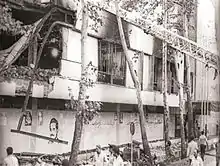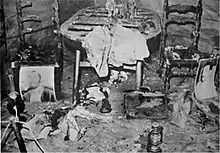1981 Iranian Prime Minister's office bombing
The office of Mohammad Javad Bahonar, Prime Minister of Iran, was bombed on 30 August 1981 by the People's Mujahedin of Iran (MEK),[4][5] killing Bahonar, President Mohammad Ali Rajai, and six other Iranian government officials.[6] The briefcase bombing came two months after the Hafte Tir bombing, which killed over seventy senior Iranian officials, including Chief Justice Mohammad Beheshti, then Iran's second-highest official.
| 1981 Iranian Prime Minister's office bombing | |
|---|---|
| Part of Terrorism in Iran | |
 The Iranian PM building after the explosion | |
| Location | Tehran, Iran |
| Date | 30 August 1981 15,[1] 14:45[2] (+3:30) |
| Target | Iranian officials |
Attack type | Bombing |
| Deaths | 8[3] |
| Injured | 23[3] |
| Assailants | Masoud Keshmiri (agent of MEK) |
According to sources, nobody "knew exactly who had been in the room at the time of the detonation." Eventually, there were three participants that had been unaccounted for that included Masoud Keshmiri, Rajai, and Bahonar. It was later revealed that both Rajai and Bahonar had died in the explosion.[7] According to Albert Benliot, Ayatollah Khomeini charged the MEK with responsibility for the bombing, "however, there has been much speculation among academics and observers that these bombings may have actually been planned by senior IRP leaders, including later Iranian President Ali Akbar Hashemi-Rafsanjani, to rid themselves of rivals within the IRP."[8]
Afterwards, the interim presidential council announced five national days of mourning, and Iran's Parliament selected Ayatollah Mahdavi Kani as the next prime minister.
Bombing
.jpg.webp)

According to the survivors, the bomb exploded when one of the victims opened a briefcase brought by Masoud Keshmiri as an "agent of MEK".[9] Ettela'at reported that the explosion destroyed the first floor and partially damaged the second floor of the Prime Minister's building, located on Pastor Street. Rajai, Bahonar, and military and security officials were killed. The injured were rescued from the rubble and transported to the hospital. Due to their severe burns, the corpses were not easily identified, and some of the victims were identified through their teeth.[3]
Prominent officials killed
- President Mohammad Ali Rajai
- Prime Minister Mohammad Javad Bahonar
- Col. Vahid Dastjerdi, chief of Iranian police
- Abdol Hossein Daftarian[10]
Prominent officials injured
- Col. Sayyed Mousa Namjoo, Minister of Defense and Khomeini's representative in the Supreme Defense Council
- Brigadier General Sharafkhah, Deputy Commander of Ground Forces
- Col. Vesali
- Col. Akhyani, Chief of Staff of Iran's Gendarmerie
- Col. Katiba'ee, representative of the Joint Chiefs of Staff[3]
Suspects
Although no group claimed responsibility for the bombing, it was nevertheless attributed to the MEK.[11] Ann K. Reed notes that Western observers believe the People's Mujahedin of Iran (MEK) was "most likely to have been responsible for the bomb blasts of June 28 and August 30." However, Van England notes that "the explosions were set off by insiders - the first by an accomplice working in the offices of the IRP, the second by the guard in charge of security at Prime Minister Bahonar's headquarters." Mangol Bayat also expressed doubts that the MEK would be capable the attacks "since infiltration of the regime at the very high level would have been necessary."[12] The Islamic Republic of Iran later claimed that the attack was carried out by MEK agent Masoud Keshmiri, secretary of Bahonar's office and of the Supreme National Security Council,[13] who used a fake passport to escape Iran after the attack.
More than twenty suspects were identified in the subsequent investigation, including Masoud Keshmiri, Ali Akbar Tehrani, Mohammad Kazem Peiro Razawi, Khosro Ghanbari Tehrani, Javad Ghadiri, Mohsen Sazgara, Taghi Mohammadi, and Habibollah Dadashi.[14]
Perpetrator
The Islamic Republic of Iran identified Masoud Keshmiri (who had served as Bahonar's office secretary for a year prior to the bombing) as the perpetrator. An official in the Prosecutor General's office said that Keshmiri had concealed his anti-government activities so well that a corpse mistaken for his was buried on 31 August with full honors as a martyr of the Islamic revolution.[6]
Abdol Hossein Daftarian was stuck in the elevator after the explosion, where he suffocated to death. The MEK bought some time for Keshmiri by spreading the rumor that the man found in the elevator was actually him. Although the Iranian authorities arrested and executed numerous MEK agents,[9] Keshmiri fled the country using a fake passport.[10]
Aftermath
Following the deaths of Rajai and Bahonar, an interim presidential council was formed, as stipulated by Article 130 of the Iranian Constitution. The interim council consisted of Ayatollah Akbar Hashemi Rafsanjani, then Parliament's speaker, and Ayatollah Mousavi Ardabili, then president of the Supreme Court. The council announced five national days of mourning and nominated Interior Minister Ayatollah Mahdavi Kani to Parliament as the next prime minister.[3] Parliament held an election on 2 October 1981 to elect Bahonar's successor;[6] Kani won a parliamentary vote of confidence to become prime minister, receiving 178 votes in favor, 10 votes against, and 8 abstentions (out of 196 total votes).[3]
References
- "Shahrivar 8th in the mirror of memories; The hard times of bitter assassinations: Today is the anniversary of the explosion of the Office of the Prime Minister". Farhikhtegan Newspaper (in Persian). Archived from the original on 13 December 2017. Retrieved 27 May 2017.
- "The documents of suspects of PM office + Handwriting of the bomber" (in Persian). Fars News Agency. Retrieved 28 May 2017.
- "Rajaei and Bahonar were martyred". Iranian History. Archived from the original on 24 October 2018. Retrieved 21 March 2017.
- Newton, Michael (17 April 2014). Famous Assassinations in World History. ABC-CLIO. p. 27. ISBN 9781610692861.
- Rubin, Barry; Colp Rubin, Judith (28 January 2015). Chronologies of Modern Terrorism. Routledge. p. 246. ISBN 9781317474654.
- United Press International (14 September 1981). "Iranian Says Secretary to Premier Hid Fatal Bomb in Teheran Office". The New York Times. Retrieved 14 March 2017.
- Muravchik, Joshua (23 July 2013). Trailblazers of the Arab Spring: Voices of Democracy in the Middle East. Encounter Books. ISBN 978-1594036798.
- Katzman, Kenneth (2001). "Iran: The People's Mojahedin Organization of Iran". In Benliot, Albert V. (ed.). Iran: Outlaw, Outcast, Or Normal Country?. Nova. ISBN 978-1-56072-954-9.CS1 maint: ref=harv (link)
- Newton, Michael (17 April 2014). Famous Assassinations in World History: An Encyclopedia [2 volumes]. ABC-CLIO. ISBN 9781610692861. Retrieved 14 March 2017.
- "When the secret of prime minister's elevator was decoded". Defa Press. Retrieved 27 May 2017.
- Ram, Haggay (Summer 1992). "Crushing the Opposition: Adversaries of the Islamic Republic of Iran". Middle East Journal. 46 (3): 426–439. JSTOR 42763892.
- Reed, Ann K. (1 January 1981). "Iran's Mujahideen: At the Center of Opposition". Harvard International Review. 4 (3): 10–12. JSTOR 42763892.
- Associated Press (14 September 1981). "Iran: Secret agent was bomber". The Spokesman-Review. Retrieved 15 June 2017.
- "Unsaid facts about Keshmiri, prime suspect of PM office bombing". Political Studies and Research Institute (in Persian). Retrieved 28 May 2017.